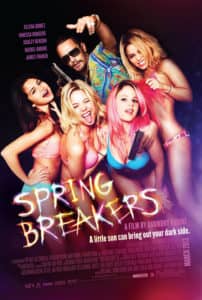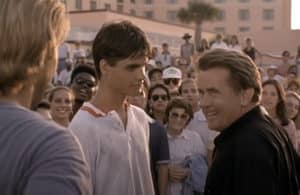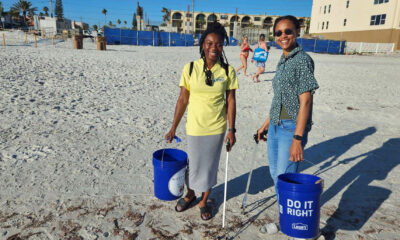Vintage St. Pete: And still more movies on location
Ray Liotta took the red-eye from Los Angeles to Tampa on March 7, 1999, and when he stumbled off the plane, around 4 a.m., the actor was detained by airport police.
Flight attendants accused the GoodFellas star of becoming verbally abusive when they declined to serve him more wine. The legal complaint included the phrase “drunk and belligerent.”
Liotta was on his way to St. Pete Beach to shoot Forever Mine, a thriller about an adulterous affair and a vengeful spouse. Considering the film’s hostile reviews, and its subsequent reputation as the first real stinker of the new millennium, perhaps Liotta, who had obviously read the script, was merely pounding drinks to steel himself for what was to come.
“So listless and numbing we need not wonder why it went directly to cable,” wrote the New Yorker.

Screengrab from “Forever Mine” (J&M Entertainment) with Gretchen Mol and Joseph Fiennes (and the Don CeSar).
Writer/director Paul (American Gigolo) Schrader and company spent a month camped at the Don CeSar making Forever Mine, in which new bride Ella Brice (Gretchen Mol) has a steamy romance with handsome cabana boy Alan Ripley, a.k.a. underachieving Manuel Esquema (British actor Joseph Fiennes, employing a cheesy Latin accent).
Sample dialogue, spoken under a pink beach umbrella:
Ella: I’m married. I’m here six more days.
Manuel/Alan: And I’m a towel boy. Isn’t it perfect?
(They kiss.)
Considering Fiennes was just coming off Shakespeare in Love, he must have thought Forever Mine, which included several soft-focus sex scenes, would constitute the next rung in his ladder of success.
Wrong!
Forever Mine is a by-the-numbers melodrama, part sexy romp and part violent psychodrama (that’d be the segments with Liotta, playing histrionic hubby Mark Brice). And except for several long, loving shots of the beach, and the pink Don CeSar architecture, it could have been made anywhere. And just as forgotten.
Liotta’s “drunk and belligerent” case was dismissed.
Other stories in this series: Making H.E.A.L.T.H., Making Cocoon, Making Summer Rental, From Bogart to Brad Pitt: St. Pete, the movie location and Making a ‘Strange’ movie in Gulfport.
Beauties and the beach
The critics were somewhat kinder to Spring Breakers, the next big-budget Hollywood movie to come to St. Pete Beach. Writer/director Harmony Korine’s drama about four bikini-wearing college girls on the loose during a particularly hedonistic Spring Break plays like a cross between Girls Gone Wild and Reservoir Dogs.
No wonder Quentin Tarantino declared Spring Breakers his favorite movie of 2013.
James Franco plays cornrowed rapper-slash-drug dealer Alien, who takes the young ladies under his “wing” and leads them into a life of violent crime.
 The film’s marketing campaign was centered entirely on the four nearly-naked and apparently brain-dead women (played by former Disney stars Vanessa Hudgens and Selena Gomez, along with Ashley Benson and Rachel Korine, the director’s wife).
The film’s marketing campaign was centered entirely on the four nearly-naked and apparently brain-dead women (played by former Disney stars Vanessa Hudgens and Selena Gomez, along with Ashley Benson and Rachel Korine, the director’s wife).
On March 13, 2012, the film company spent three hours on Corey Avenue, as the quartet of celebrity nubiles rode scooters up and down, back and again, to the cheers of extras in T-shirts and swimsuits, toasting the “hottie biker gang” with cans, bottles and open containers of (fake) beer.
On March 21, the stars and 500 local extras gathered in and around the pool at the Coral Reef Beach Resort for the movie’s biggest, loudest and most Bacchanalian scene. They danced, they screamed, they raised their ever-present beverages in the air.
St. Petersburg High student Angela Skane worked as an extra that day, and reported for the Tampa Bay Times. Her story began: ‘Are any of you comfortable with making out with another girl?’ was not something I expected to hear at 10 in the morning.
The extras were not compensated, although girls who were willing to remove their tops and lewdly shake for the cameras were paid $150, Skane wrote.
Along with its many scenes of titillation, public drunkenness and drug use, Spring Breakers showed the world an image of St. Pete Beach – yes, it’s called that in the movie – that doesn’t actually exist. Certainly not as a ground zero for anything-goes spring breakers.
Twitter, Instagram and the other social media outlets were all gaga, however, when Gomez, the film’s breakout star, turned up unexpectedly at stores or restaurants, sometimes in the company of her boyfriend, Justin Bieber. The actress happily signed autographs and posed for photos.
Additional scenes were filmed at the Gulfport Police Department, at the Sunshine Skyway Bridge and on the Redington Long Pier. The company left town before March turned to April.

From left Daniel Stern, Arye Gross and Patrick Dempsey on the Snell Isle Bridge in the Universal movie “Coup de Ville.” Screengrab.
Cross-country comedy
Considerably more extras were needed for the comedy Coupe de Ville, which required several scenes set at a Florida dog racing track. Derby Lane fit the bill, although it was closed for the season when the filmmakers came calling in June, 1989. So they paid extra (a lot extra) to have employees – and dogs – all dressed for business and ready to go when actors Patrick Dempsey and Daniel Stern turned up to “place a bet.” In the movie, they (along with Arye Gross) play estranged brothers who bond during a road trip across country in a powder-blue Cadillac Coupe de Ville.
 The call went out for 3,000 extras to dress in “late ‘50s, early ‘60s conservative night wear” for two evenings of providing human background. Approximately 2,000 arrived on the first night. After sitting out a downpour, cast, crew and extras got to work.
The call went out for 3,000 extras to dress in “late ‘50s, early ‘60s conservative night wear” for two evenings of providing human background. Approximately 2,000 arrived on the first night. After sitting out a downpour, cast, crew and extras got to work.
The Derby Lane sequences were finished the following night.
Coupe de Ville turned its attention to the Snell Isle Bridge, where Dempsey, Gross and Stern shot another scene (their prized car is threatened by tough guys wielding baseball bats).
The production company donated $2,000 to the Property Owners Association beautification project, as a way of apologizing for holding up traffic during the two days it took to film the brief sequence.
The six-day shoot wrapped on June 28, as Stern and Dempsey were filmed walking into Center Jewelers on 1st Avenue North. Movies are generally shot out of sequence, so this scene was to come before the Derby Lane material in the finished film.
“Coupe de Ville,” Roger Ebert said in his review, “is composed of so many formulas that they must have a template for it in screenwriting school.”
Game, set, match
The low-budget tennis drama The Break borrowed a well-worn sports-movie formula (from Rocky to The Karate Kid to The Mighty Ducks to Happy Gilmore, even): The underdog beats the odds, and the underhanded machinations of an arrogant champion, to WIN THE BIG GAME!
This 1995 non-starter was written and produced by former child actor Vincent Van Patten, son of Eight is Enough star Dick Van Patten. He cast himself as the bitter, washed-up tennis pro who coaches a hopeless young upstart (Ben Jorgensen) all the way to the top.
The climactic tournament scene was lensed at the Vinoy Resort in St. Petersburg over several days in September 1993.

From left: Vincent Van Patten, Ben Jorgensen, local extras and Martin Sheen. Screengrab.
Actors Van Patten, Jorgensen and Rae Dawn Chong were there to work, along with several hundred extras. And seated in the “grandstands” was Martin Sheen, who was playing the Jorgensen character’s wealthy, distant dad. He was filmed watching the “match.” When his son emerged triumphant, dad embraced him and gave a short, moving speech.
The Break was clearly a time-killing “paycheck movie” for Sheen, still six years away from his career revival on The West Wing.
In November, a mini-scandal erupted when hundreds of St. Pete and Orlando crew members and craftsmen complained that they had not been paid for their work on the $2.75 million movie. “It was a miscalculation,” producer Van Patten told Times film writer Steve Persall. “To be quite honest, at the end of the film we found out we ran out of money.”
Van Patten then reassured the cheated workers that the checks were, in fact, in the mail.
Once the financial mess was cleaned up, the film failed to find a distributor, and was released directly to video in 1996.

In Paramount’s “Bang the Drum Slowly”: Michael Moriarty and Anne Wedgeworth at the the Hourglass Lounge, inside the Fort Harrison Hotel in Clearwater, May 1972. Screengrab.
Catching up
One of the most beloved sports movies of all time, 1973’s Bang the Drum Slowly, has a Pinellas County connection.
Numerous scenes in the film, Robert De Niro’s first as an above-the-title star, were shot in Clearwater in 1972.
Based on the novel by Mark Harris, Bang the Drum Slowly is the story of the New York Mammoths, a major league baseball team, and the tensile friendship between star pitcher Henry Wiggen and his best pal, catcher Bruce Pearson.
No one on the team – including coach Vincent Gardenia, a real scenery-chewer – understands why Henry is so devoted to Bruce, who is considered something of a half-wit, and one of the lesser Mammoths. At least one player wonders out loud if they’re “fairies.”
The audience is let into the secret early – Bruce is dying of Hodgkin’s Lymphoma, and Henry is simply trying do right by his friend.
One of the classic sports-movie tearjerkers, Bang the Drum Slowly arrived on the heels of the TV film Brian’s Song, which featured a similar storyline (set in the world of football).
Members of the cast were filmed at Morton Plant Hospital and Sylvan Abbey Memorial Park.
Although most of the baseball footage was shot at Yankee Stadium and Shea Stadium, Clearwater’s Jack Russell Stadium stood in for the Mammoths’ Spring Training home.
Moriarty, De Niro and actress Ann Wedgeworth were filmed at a table inside the Hourglass Lounge, inside the Fort Harrison Hotel. De Niro and Wedgeworth took a turn around the dance floor.
Times writer Mary O. McKey chronicled her day working as an extra in this scene, and reported that others scenes had been shot on the hotel roof, by the pool, the Cloud Room, the Skyline Room and additional in-house locations.
“Then came the final blows to our egos,” McKey wrote, quoting a production assistant: “Just hold the cigarette in your mouth and pretend like you’re smoking. You’re all so much out of focus in the background that you can’t tell the difference anyway.”
Wedgeworth, who was at that time appearing on the soap opera Somerset, was the only “name” actor participating in the Hourglass Lounge sequence. Moriarty would make his name many years later as Ben Stone, the pre-Sam Waterston assistant district attorney on Law & Order.
And De Niro, then just 28 years old, was still a couple of movies away from becoming ROBERT DE NIRO.
His next three, made in quick succession, were Mean Streets, The Godfather Part II and Taxi Driver.

At Jack Russell Stadium, Clearwater, May 1972: Robert De Niro (second from right) in Paramount’s “Bang the Drum Slowly.” Screengrab.







